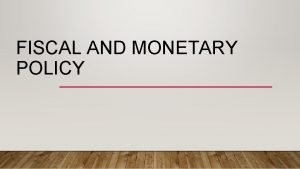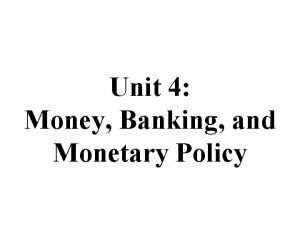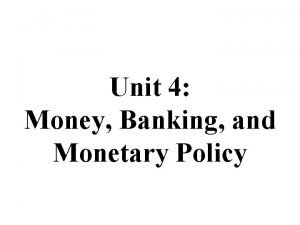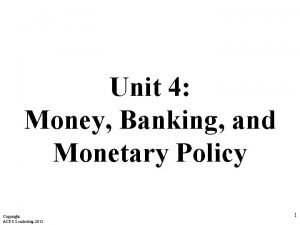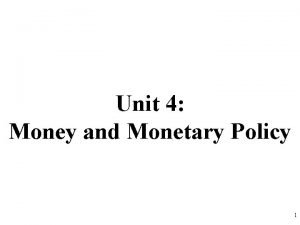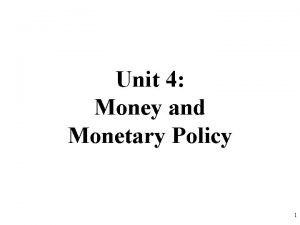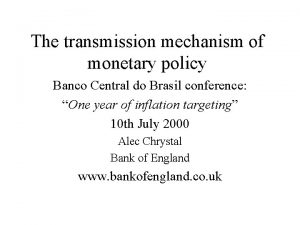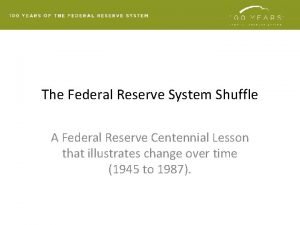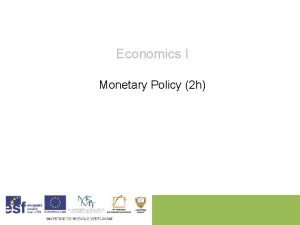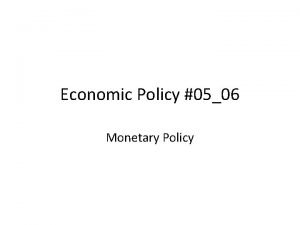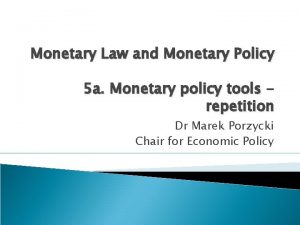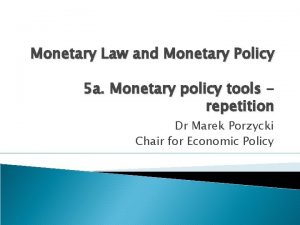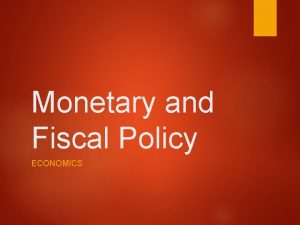FISCAL AND MONETARY POLICY Fiscal Policy Fiscal policy













- Slides: 13

FISCAL AND MONETARY POLICY

Fiscal Policy Fiscal policy the federal government’s use of taxing and spending to keep the economy stable. Expansionary Policies Fiscal policies that try to increase output are known as expansionary policies. (Increase Government Spending, Cutting Taxes) Contractionary Policies Fiscal policies intended to decrease output are called contractionary policies. (Decrease Government Spending, Raising Taxes)

Monetary Policy Monetary policy is one of the ways that the U. S. government attempts to control the economy. If the money supply grows too fast, the rate of inflation will increase; if the growth of the money supply is slowed too much, then economic growth may also slow. Monetary Policy Tools Reserved Ratio Requirement Discount Rate the interest rate that banks pay to borrow money from the Fed. Open market operations are the buying and selling of government securities to alter the money supply.

Monetary Policy How Banks Create Money Assume that you have deposited $1, 000 dollars in your checking account. The bank doesn’t keep all of your money, but rather lends out some of it to businesses and other people. The portion of your original $1, 000 that the bank needs to keep on hand, or not loan out, is called the required reserve ratio (RRR). The RRR is set by the Fed. As the bank lends a portion of your money to businesses and consumers, they too may deposit some of it. Banks then continue to lend out portions of that money, although you still have $1, 000 in your checking account. Hence, more money enters circulation.

Expansionary and Contractionary Tools of Fiscal and Monetary Policy The federal government and the Federal Reserve both have tools to influence the nation’s economy. Fiscal and Monetary Policy Tools Fiscal policy tools Expansionary tools 1. increasing government spending 2. cutting taxes 1. Decreasing Contractionary tools government spending 2. raising taxes Monetary policy tools 1. open market operations: bond purchases 2. decreasing the discount rate 3. decreasing reserve requirements 1. open market operations: bond sales 2. increasing the discount rate 3. increasing reserve requirements

Debt and Deficit -The amount of money the government borrows for one budget, representing one fiscal year -Can rise or fall because of forces beyond the government’s control -Borrowing money affects both debt and deficit -Budget deficits add to debt -Debt and deficit contribute to unbalanced budgets Debt -The sum of all the government borrowing up to that time, minus the borrowings that have been repaid -The total of all deficits and surpluses

Keynesian economics Keynesian Economics A form of demand-side economics that encourages government action to increase and decrease demand output Demand-side Economics The idea that government spending and tax cuts help an economy by raising demand John Maynard Keynes Developed this theory after the Great Depression. His ultimate goal was to tell economists and politicians how to get out of and avoid economic crisis

Keynesian economics Keynes believe that 2 things needed to happen to end the Great Depression 1. Consumers need to spend more money �Keynes thought that the spender should be the government. According to his theory, the government should buy goods and services. This would encourage production and increase employment. 2. Businesses need to increase output As a result of this theory, people go back to work and then spend the money they make on goods and services – this increases production.

Fiscal Policy The use of government spending to influence the economy Fiscal policy can be used to fight two macroeconomic problems, according to Keynes

Fiscal Policy Expansionary Policy 1. Recession (decline in economic prosperity)/Depression (long recession) Government should increase spending OR government should decrease taxes Contractionary Policy 2. Inflation (general increase in prices) Government should decrease spending OR government should increase taxes

Supply Side Economics Supply-side Economics A school of economics that believes that tax cuts can help an economy by raising supply Those that agree with supply-side economics believe that taxes have strong negative influences on economic output Trickle down effect Investing money in companies and giving them tax breaks will benefit the economy. Eventually individuals (consumers) will experience the effects thus trickle down to the households

The Federal reserve and government economic policy Contractionary Policy (Tight $$) – during inflation 1. Increase interest rates 2. Increase reserve requirement ($$ banks must have in reserve) 3. Increase taxes 4. Decrease government spending

The Federal reserve and government economic policy Expansionary Policy (Easy or Loose $$) – during recession/depression 1. decrease interest rate (easy to buy) 2. decrease taxes 3. decrease reserve requirements (banks have more $$ to loan) 4. increase government spending
 Contractionary money policy
Contractionary money policy Fiscal vs monetary policy
Fiscal vs monetary policy Unit 4 money banking and monetary policy
Unit 4 money banking and monetary policy Unit 4 money banking and monetary policy
Unit 4 money banking and monetary policy Unit 4 money and monetary policy
Unit 4 money and monetary policy Unit 4 money and monetary policy
Unit 4 money and monetary policy Unit 4 money and monetary policy
Unit 4 money and monetary policy Transmission mechanism
Transmission mechanism Lesson quiz 16-1 monetary policy
Lesson quiz 16-1 monetary policy Objectives of monetary policy
Objectives of monetary policy Monetary policy
Monetary policy To type
To type What are the objectives of monetary policy
What are the objectives of monetary policy What are the objectives of monetary policy
What are the objectives of monetary policy

